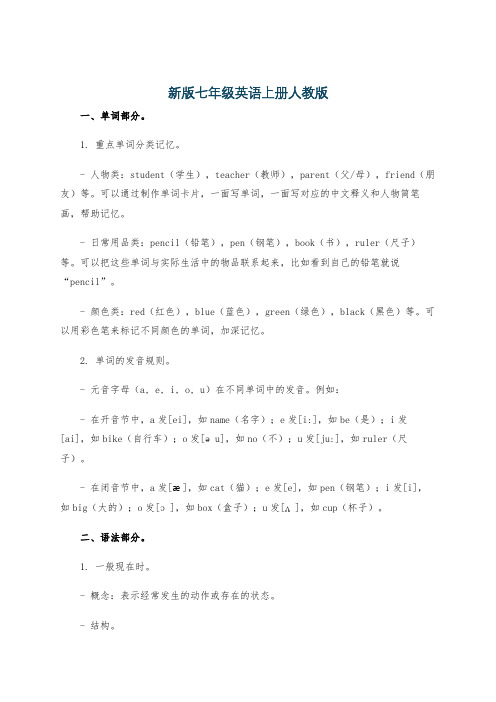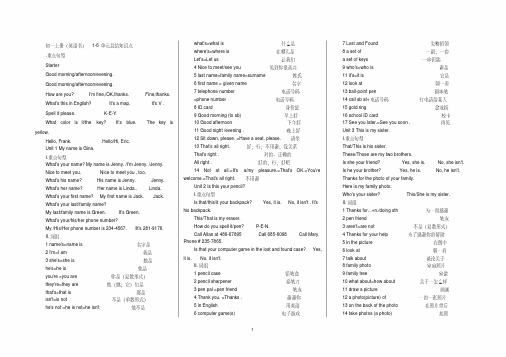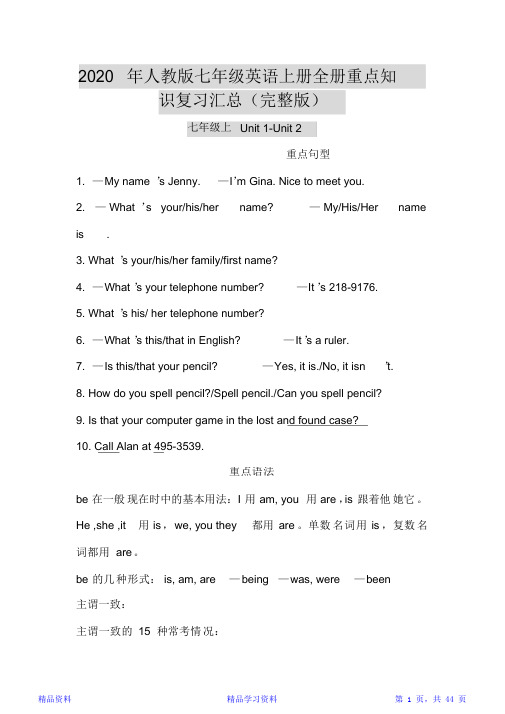2020年初一年级英语上册知识点人教版.doc
新版七年级英语上册人教版

新版七年级英语上册人教版一、单词部分。
1. 重点单词分类记忆。
- 人物类:student(学生),teacher(教师),parent(父/母),friend(朋友)等。
可以通过制作单词卡片,一面写单词,一面写对应的中文释义和人物简笔画,帮助记忆。
- 日常用品类:pencil(铅笔),pen(钢笔),book(书),ruler(尺子)等。
可以把这些单词与实际生活中的物品联系起来,比如看到自己的铅笔就说“pencil”。
- 颜色类:red(红色),blue(蓝色),green(绿色),black(黑色)等。
可以用彩色笔来标记不同颜色的单词,加深记忆。
2. 单词的发音规则。
- 元音字母(a, e, i, o, u)在不同单词中的发音。
例如:- 在开音节中,a发[ei],如name(名字);e发[i:],如be(是);i发[ai],如bike(自行车);o发[əu],如no(不);u发[ju:],如ruler(尺子)。
- 在闭音节中,a发[æ],如cat(猫);e发[e],如pen(钢笔);i发[i],如big(大的);o发[ɔ],如box(盒子);u发[ʌ],如cup(杯子)。
二、语法部分。
1. 一般现在时。
- 概念:表示经常发生的动作或存在的状态。
- 结构。
- 当主语是第一人称(I,we)、第二人称(you)和复数名词(如students,teachers等)时,动词用原形。
例如:I like English.(我喜欢英语。
)We play football after school.(我们放学后踢足球。
)- 当主语是第三人称单数(he,she,it或者单个的人或物,如my father,the cat等)时,动词要加 -s或 -es。
例如:He likes reading books.(他喜欢读书。
)She goes to school by bike.(她骑自行车上学。
)- 时间状语:often(经常),usually(通常),sometimes(有时),every day(每天)等。
(完整版)人教版七年级上册英语全册语法知识点梳理,推荐文档

第一讲:动词一.Be 动词(am, is, are)的用法口诀:I 用 am , you 用 are ,is 连着他(he)她(she)它(it)。
单数全部用 is,复数一律都用 are. 变疑问,往前提,句末问号莫丢弃,变否定,更容易,be 后 not 莫忘记,句首大写莫迟疑。
I a student. You Japanese.He my brother. She very nice.My name Harry. LiLei very tall.This book very interesting. Li Lei and I good friends.These apples. Those bananas.They students. There some bread on the plate.The cat black. The black pants for Su Yang.Here some sweaters for you. There a girl in the room.There some milk for me. There some apples on the tree.Gao Shan's shirt over there. Some tea in the glass.二.一般现在时态1.用法:(1).表示习惯性,经常性的动作,常与o f t e n,a l w a y s,u s u a ll y,e v e r y d a y/w ee k/m o n t h…等词连用I o f t e n p l a y s o cc e r.(2).表示主语具备的性格或能力:H e li k e s t o e a t b a n a n a s.2.在一般现在时态中,当主语是第三人称单数时,谓语动词也用第三人称单数, 第三人称单数的构成规则(主语不是第三人称单数时谓语动词用原形):a.一般情况下在动词词尾加 s 如:get----gets like----likes play—plays, want—wants,work—works,b.以字母 s、x、ch, sh,o 结尾的动词加-es:guess—guesses, fix—fixes, teach—teaches,brush—brushes, go—goes,c.以辅音字母+y 结尾的动词,先变y 为i,再加-es:study—studies,carry—carries,fly—flies,特殊词: have --- has一写出下列动词的三单形式。
人教版初中英语七年级上册全册各单元知识点、语法归纳整理

人教版初中英语七年级上册全册各单元知识点、语法归纳整理She’s my sister.她是我的妹妹。
3.This is a picture of my family.这是我家人的一张照片。
4.In the first photo。
there’s my XXX.在第一张照片里,有我的爷爷。
5.This is my family tree.这是我的家谱。
6.What’s the name of your father?你父亲叫什么名字?7.Have a good day!过得愉快!重点语法1.名词所有格2.复数形式3.人称代词宾格4.指示代词this和these的用法5.介绍人物时的基本用语:This is …/These are…1.指示代词:this。
that。
these。
those - 这个,那个,这些,那些2.名词复数规则:1)一般情况下直接加s。
2)以s,x,sh,ch结尾的加es。
3)以辅音字母加y结尾的将y变i再加es。
4)以o结尾的加s或es。
(有生命+es物生命加s)5)以f/fe结尾的名词,先将f/fv变成v再加es。
3.人称代词:I。
he。
she。
it和they - 我,他,她,它,他们/她们/它们4.重点短语:Is this/that your。
- 这/那是你的……吗?Yes。
it is。
/ No。
it isn't。
- 是的,是它。
/ 不,不是。
XXX。
- 这些/那些是我的……Here are。
- 这里有……This/That is my。
- 这/那是我的……Have a good day。
- 祝你玩得愉快!Excuse me for interrupting。
but could I ask you a n?Thank you very much.Could you please speak in English?Do you enjoy playing computer games?Have you checked in the lost and found case to see if your item is there?Please call 685-6034 to reach me.I lost my school ID card and need to find it.I need a set of pencils for my art class.Key XXX structures:Is that your school bag?No。
新人教版英语七年上册全册知识点归纳(重点难点要点)初一英语 共81页

新人教版七年英语上册全册知识点归纳(重点难点要点)(一)Unit1My name’s Gina一、学习重点【句型】What’s your name?你叫什么名字?1、My name is Gina.我叫吉娜/I’m Gina.2、Nice to meet you.见到你很高兴。
3、What’s….number?……号码是多少?【口语】(一)常见的问候表达方式有:1、Hello/Hi2、Good morning/afternoon/evening/night3、Nice to meet you/Nice to meet you,too4、How are you?5、How do you do?(二)常见的介绍表达方式有:1.I’m…/My name’s…/This is…/These are…and….2.Nice to meet you.3.What’s your phone number?4.It’s2842942.【语法】1、be的一般现在时形式2、What引导的特殊疑问句3、形容词性物主代词:my,your,his,her二、难点讲评1.My name’s Jenny.我的名字叫詹尼。
释:两人初次见面时,应首先把自己的姓名介绍给对方,是比较礼貌的。
My name’s是my name is的缩写形式,表示“我的名字……”,“My name is+姓名”是自我介绍的惯用句型。
例如:My name’s Ann.我的名字叫安。
注:对于What’s your name?的回答也常用“My name is…”这个句型。
“I am+姓名,”表示“我是……”,介绍自己姓名的另一种方式。
例如:I’m Mary.我是玛丽=My name is Mary.2.Nice to see you.见到你很高兴。
释:这句话是一个省略句,完整的形式为:“It’s nice to meet you.”双方初次见面经介绍后常说Nice to meet you.这是陌生人初次见面的客套话。
人教版七年级英语上册1-6单元重点知识总结

初一上册(英语书)1-6单元总结知识点.重点句型StarterGood morning/afternoon/evening.Good morning/afternoon/evening.How are you? I'm fine,/OK,thanks. Fine,thanks.What's this in English? It's a map. It's V.Spell it please. K-E-Y.What color is it/the key? It's blue. The key is yellow.Hello, Frank. Hello/Hi, Eric.Unit 1 My name is Gina.I.重点句型What's your name? My name is Jenny. /I'm Jenny. /Jenny.Nice to meet you. Nice to meet you , too.What's his name? His name is Jenny. Jenny.What's her name? Her name is Linda.. Linda.What's your first name? My first name is Jack. Jack.What's your last/family name?My last/family name is Green. It's Green.What's your/his/her phone number?My /His/Her phone number is 234-4567. /It's 281-9176.II.词组1 name's=name is 名字是2 I'm=I am 我是3 she's=she is 她是he's=he is 他是you're =you are 你是(复数形式)they're=they are 他(她;它)们是that's=that is 那是isn't=is not 不是(单数形式)he's not =he is not=he isn't 他不是what's=what is 什么是where's=where is 在哪儿是Let's=Let us 让我们4 Nice to meet/see you 见到你很高兴5 last name=family name=surname 姓氏6 first name = given name 名字7 telephone number 电话号码=phone number 电话号码8 ID card 身份证9 Good morning (to sb) 早上好10 Good afternoon 下午好11 Good night /evening . 晚上好12 Sit down, please. =Have a seat, please. 请坐13 That's all right. 好;行;不用谢;没关系That's right . 对的、正确的All right . 好的,行,好吧14 Not at all.=It's a/my pleasure.=That's OK.=You'rewelcome.=That's all right. 不用谢Unit 2 Is this your pencil?I.重点句型Is that/this/it your backpack? Yes, it is. No, it isn't . It'shis backpack.This/That is my eraser.How do you spell it/pen? P-E-N.Call Allan at 486-67895 Call 685-6098 Call Mary.Phone # 235-7865.Is that your computer game in the lost and found case? Yes,it is. No, it isn't.II.词组1 pencil case 铅笔盒2 pencil sharpener 卷笔刀3 pen pal =pen friend 笔友4 Thank you. =Thanks . 谢谢你5 in English 用英语6 computer game(s) 电子游戏7 Lost and Found 失物招领8 a set of 一副;一套a set of keys 一串钥匙9 who's=who is 谁是11 it's=it is 它是12 look at 朝…看13 ball-point pen 圆珠笔14 call sb at+电话号码打电话给某人15 gold ring 金戒指16 school ID card 校卡17 See you later.=See you soon . 再见Unit 3 This is my sister.I.重点句型That/This is his sister.These/Those are my two brothers.Is she your friend? Yes, she is. No, she isn't.Is he your brother? Yes, he is. No, he isn't.Thanks for the photo of your family.Here is my family photo.Who's your sister? This/She is my sister.II.词组1 Thanks for...+n./doing sth 为…而感谢2 pen friend 笔友3 aren't=are not 不是(复数形式)4 Thanks for your help 为了感谢你的帮助5 in the picture 在图中6 look at 朝…看7 talk about 谈论关于8 family photo 家庭照片9 family tree 家谱10 what about=how about 关于…怎么样11 draw a picture 画画12 a photo(picture) of …的一张照片13 on the back of the photo 在照片背后14 take photos (a photo) 拍照Unit 4 Where's my backpack?I.重点句型Where's my backpack? It's under the table. Where are your baseballs? They're on the floor.Is the baseball on the sofa? Yes ,it is. No, it isn't.I don't know.Are they on the bed? Yes, they are./ No, they aren't. Are these/those your books? Yes, they are. No, they aren't. Please take these things to your sister.Can you bring some things to school?The keys are in the drawer.Here's my room.II.词组1 in the drawer 在抽屉里2 don't=don not 不是(动词主语形式)3 in pair 成对的4 Goodbye.= Bye-bye 再见5 behind the computer 在电脑后面6 write down 写下;记下7 I'm sorry 对不起8 act out 表演出来9 alarm clock 闹钟10 video tape 录像带11 soccer ball 英式足球12 school bag 书包13 in the backpack 在书包里14 under the bed 在床下15 on the chair 在椅子上16 on the dresser 在梳妆台上17 math book 数学书18 take sth to…(there/him/+地点) 把…带去19 bring sth to …(here/me/+地点) 把…带来20 the math book 这本数学书21 the notebook 这个笔记本22 on the floor 在地上Unit 5 Do you have a soccer ball?I.重点句型Do you have a ping-pong ball?Yes, I do. No, I don't.Does he/she have a tennis racket?Yes, he/she does. No, he/she doesn't.Let's play ping-pong.It's boring.That sounds good/interesting.I don't have a ping-pong ball.He/She doesn't have a volleyball.She/He has a great sports collection.We have many sports clubs.He watches them on TV.Do you have some more paper? Yes, I do. /No, I don't.II.词组1 tennis racket 网球拍2 baseball bat 棒球球拍3 doesn't=does not 不是(动词三单形式)4 watch TV 看电视5 have /play/do sports 做运动6 a good idea 一个好主意7 every day/morning/Sunday/…每天/每个早上/…8 watch a game(s) 看比赛/游戏9 like doing 喜欢做某事(爱好)10 like to do 喜欢做某事(特定时间)11 a ping-pong bat 乒乓拍12 That sounds interesting(fun)/good/difficult/boring/relaxing.那听起来很有趣/好/困难/无聊/轻松。
2020年人教版七年级英语上册全册重点知识复习汇总(完整版)(精华版)

2020 年人教版七年级英语上册全册重点知识复习汇总(完整版)七年级上Unit 1-Unit 2重点句型—M y name ’s Jenny. —I’m Gina. Nice to meet you.1.—What ’s —My/His/Her2. your/his/her name? name is .3. What ’s your/his/her family/first name?4. —W hat ’s your telephone number?—It ’s 218-9176.5. What ’s his/her telephone number?6. —W hat ’s this/that in English?—I t ’s a ruler.7. —I s this/that your pencil? —Y es, it is./No, it isn ’t.8. How do you spell pencil?/Spell pencil./Can you spell pencil?9. Is that your computer game in the lost and found case?10. Call Alan at 495-3539.重点语法be 在一般现在时中的基本用法:I 用am, you 用are,is跟着他她它。
He ,she ,it 用is ,w e, you they 都用are 。
单数名词用is ,复数名词都用are 。
be 的几种形式:is, am, are —being —w as, were —b een主谓一致:主谓一致的15 种常考情况:1.表示时间,重量,数目,价格,长度,数学运算等的词或短语作主语时,尽管他们是复数形式,但如果把这些复数形式的词或短语看作是一个整体,谓语动词用单数形式。
Two months is quite a long time. Twenty dollars is enough.2.动词不定式,动名词,从句或不可数名词作主语时,谓语动词用单数。
2024 人教版七年级英语上册知识点

2024人教版七年级英语上册知识点1.Starter Unit1Good morning!(1)重点短语:∙Good morning!(早上好!)∙Good afternoon!(下午好!)∙Good evening!(晚上好!)∙How are you?(你好吗?)∙I'm fine,thanks.(我很好,谢谢。
)(2)例句:∙Good morning,Miss Li!(早上好,李老师!)∙Good afternoon!Nice to see you.(下午好!很高兴见到你。
)∙Good evening!What are you doing?(晚上好!你在做什么?)∙How are you today?(你今天怎么样?)∙I'm fine,thanks.And you?(我很好,谢谢。
你呢?)(3)重点语法:∙字母的读音和书写:掌握26个英文字母的大小写形式、读音及基本书写规范,这是学习英语的基础。
∙音标基础:初步接触一些简单的音标,为后续学习单词的正确发音做准备,比如元音音标/æ/、/e/、/ɪ/等和一些简单的辅音音标/p/、/b/、/t/等。
∙Be动词的简单用法:学习Be动词am、is、are的最基本用法。
在这个单元中,主要让学生了解I搭配am,you搭配are,这是最基础的Be动词搭配形式。
2.Starter Unit2What's this in English?:(1)重点单词:map(地图)cup(杯子)ruler(尺子)pen(钢笔)orange(橙子)jacket(夹克衫)key(钥匙)quilt(被子)what(什么)in(在……里)English(英语;英文)。
(2)重点短语:∙询问物品:What's this in English?(这个用英语怎么说?)、What's that inEnglish?(那个用英语怎么说?)∙回答方式:It's a/an...(它是一个……)。
人教版初一上册英语知识点归纳总结

人教版初一上册英语知识点归纳总结一、48个国际音标及26个英文字母的正确书写要熟练掌握元音和辅音,5个元音字母(a, e, i, o, u),字母的正确占格及单词间距。
二、be动词的用法be动词有三种变形,分别是:am, is, are。
记忆口诀:"我"用am, "你"用are, is用于"他、她、它";单数全都用is,复数全部都用are。
三、人称及人称代词的不同形式(主格和宾格)1、三种人称:第一人称(I, we),第二人称(you, you),第三人称(he, she, it, Maria)。
2、人称代词的主格,即人称代词位于句子主语位置时的形态:I, We, You, You, He, She, It, Maria。
3、人称代词的宾格,即人称代词位于句子宾语位置时的形状:me, us, you, you, him, her, it。
4、形容词性物主代词:my, our, your, your, his, her, its, their。
5、名词性物主代词:mine, ours, yours, yours, his, hers, its, theirs。
6、反身代词:myself, ourselves, yourself, yourselves, himself, herself, itself,XXX。
四、基数词(表示数量多少的词,大致相当于代数里的自然数)zero, one, two, three, four, five, six, seven, eight, nine, ten, eleven, XXX,XXX, fourteen, fifteen, XXX, XXX, XXX, XXX, XXX,XXX-one, twenty-two, XXX-three,twenty-four, XXX-five, XXX-six,XXX-seven, XXX-eight, XXX-nine, thirty, forty, fifty, sixty,XXX,eighty, ninety, one hundred,one XXX。
- 1、下载文档前请自行甄别文档内容的完整性,平台不提供额外的编辑、内容补充、找答案等附加服务。
- 2、"仅部分预览"的文档,不可在线预览部分如存在完整性等问题,可反馈申请退款(可完整预览的文档不适用该条件!)。
- 3、如文档侵犯您的权益,请联系客服反馈,我们会尽快为您处理(人工客服工作时间:9:00-18:30)。
2020 年初一年级英语上册知识点人教版一、48 个国际音标及26 个英文字母的准确书写要熟练掌握元音和辅音, 5 个元音字母(a, e, i, o, u), 字母的准确占格及单词间距。
二、be 动词的用法be 动词有三种变形,分别是:am, is, are 。
记忆口诀:“我”用am, “你”用are, is 用于“他、她、它”; 单数全都用is ,复数全部都用are。
三、人称及人称代词的不同形式( 主格和宾格)1、三种人称:第一人称(I, we) ,第二人称(you, you) ,第三人称(he, she, it, Maria) 。
2、人称代词的主格,即人称代词位于句子主语位置时的形态:I, We, You, You, He, She, It, Maria 。
3、人称代词的宾格,即人称代词位于句子宾语位置时的形态:me, us, you, you, him, her, it 。
4、形容词性物主代词:my, our, your, your, his, her, its,their 。
5、名词性物主代词:mine, ours, yours, yours, his, hers,its, theirs 。
6、反身代词:myself, ourselves, yourself, yourselves,himself, herself, itself, themselves 。
四、基数词( 表示数量多少的词,大致相当于代数里的自然数)zero, one, two, three, four, five, six, seven, eight,nine, ten, eleven, twelve, thirteen, fourteen, fifteen,sixteen, seventeen, eighteen, nineteen, twenty, twenty-one,twenty-two, twenty-three,twenty-four, twenty-five, twenty-six,twenty-seven, twenty-eight, twenty-nine, thirty, forty, fifty,sixty,seventy, eighty, ninety, one hundred,one hundred andone。
五、一般疑问句及特殊疑问句1、一般疑问句:能用Yes或No来回答的问句。
一般疑问句句尾读升调。
2、特殊疑问句:不能用Yes或No来回答的问句。
特殊疑问句句尾读降调。
六、可数名词变复数可数名词变复数时,有规则变化和不规则变化两种。
1、规则变化:1) 一般情况直接在词尾加“-s”,如:cake-cakes, bag-bags,day-days, face-faces, orange-oranges 等;2) 以s, x, sh, ch 结尾的词,要在词尾加“- es ”,如:bus- buses, watch-watches, box-boxes 等;3) 以辅音字母加y 结尾的词,变y 为i 再加“- es ”,如:baby- babies, country-countries, family-families 等;4) 部分以f (e) 结尾的词,变 f (e) 为“ves ”,如:knife- knives, half-halves 等;5) 以o 结尾的词,加“-s”或“- es ”,如:zoo-zoos, photo- photos, tomato-tomatoes, potato-potatoes 等。
记忆口诀:除了“英雄”hero 外,凡是能吃的,加“- es ”,不能吃的加“- s ”。
2、不规则变化:1) 改变单数名词中的元音字母:man-men, woman-women, foot-feet, tooth-teeth 等;2) 单、复同形:sheep-sheep, Chinese-Chinese, Japanese-Japanese 等;3) 其他形式:mouse-mice, child-children 等。
七、简单句的成分及主谓一致原则最基本构成:主语+谓语+宾语,其中谓语由动词来充当。
主谓一致原则,就是句子的谓语要始终与主语保持数量上的一致性。
当主语是第三人称单数(简称“三单”) 时,谓语动词也要相对应变成单数形式; 当主语非“三单”时,谓语动词就用原形。
实意动词变“三单”的规则如下:1) 一般动词在词尾加“-s”,如:like-likes, tell-tells,play-plays 等;2) 以字母s, x,ch, sh 结尾的动词加“- es ”,如:guess- guesses, teach-teaches, watch-watches 等;3) 以o 结尾的动词一般加“- e s ”,如:do-does, go-goes 等;4) 以辅音字母加y 结尾的动词,先变y 为i ,再加“- 而是”,如:fly-flies, carry-carries 等;5)have 的三单形式是has。
八、冠词的用法( 名词前面必须要有冠词)冠词分为定冠词(the) 和不定冠词(a, an) 两种。
1、定冠词the 表示“特指”,可译为“这个”、“那个”、“这些”、“那些”。
2、不定冠词a, an 用来表明( 可数) 名词的数量是“一个”。
an 用于以元音开头(注意不是以元音字母开头) 的单词前,a 则英语非元音开头的单词前。
3、不定冠词a, an 与基数词one 的区别是:不定冠词不是刻意强调“数量”,而基数词则强调“数量”。
九、助动词(do, does ) 的用法只有实意动词作谓语时才涉及使用助动词。
以like 为例:1) 当句子为肯定句时不涉及使用助动词,只涉及“主谓一致”原则。
eg :I like English a lot.Michael likes Chinese food very much.2) 当句子为否定句时,要根据主语的人称来决定使用相对应的助动词:当主语为“三单”时,要使用does; 当主语为“非三单”时,用助动词原形do。
例如把下列句子变否定句:Kangkang likes math.----Kangkang doesn't like math.They like sports.------They don't like sports.3) 当句子变疑问句时,同样要根据句子的主语来决定在句首使用Do或Does.例如下列句子变问句:Michael likes Chinese Food.----Does Michael like Chinesefood? Yes, he does./ No, he doesn't.Jane and Helen like music.----Do Jand and Helen likemusic? Yes, they do./ No, they don't.十、名词所有格1、Kangkang's books;Tom and Helen's desk; Ann's andMaria's bikes;2、用of 表示“...... 的”,但要从of 后往of 前翻译:a bookof mine( 我的一本书)3、have 与of 的区别:have 一般表示“主动拥有”,往往用于有生命的人或动物; 无生命的物体一般不能“主动拥有”,表示所属关系时要用of 。
例如:I have a new bike. She has two big eyes.a door of the house 十一、课本中的知识点1、Unit 1 ——Unit 21) 问候语:Good morning/ afternoon/ evening.How are you?---Just OK, thank you. How are you?---Not bad,thanks.Hi! Hello!How do you do?2) 道别用语:Nice/ Glad to meet/ see you.(meet 用于初次见面,see 用于熟人间)Nice to meet/ see you, too.Goodbye. Byebye. Bye. See you (later/ tomorrow/ nexttime)! So long! Good night!3) 介绍人或者物的句型:This is...4)Excuse me. 与I'm sorry. 的区别:Excuse me. 是要引起对方的注意,而I'm sorry. 则是向对方道歉。
5) 词组be from = come fromin English5) 当问句中问到this/ that 时,回答要用it; 问到these/ those 时,要用they 来回答。
例如:What's this in English?----It'san eraser.What are those?----They are books.6) 对Thanks.的回答:That's OK./ You're welcome./ Mypleasur.7)look the same = have the same looksgive sth. to sb. = give sb. sth.be like = look likein the tree/ on the tree ( 树上结的、长出来的用on,否则用in)in red( 穿着红色的衣服)in the desk( 在空间范围之内)in English( 用英语)help sb. do sth.8)both 与all 的区别:。
